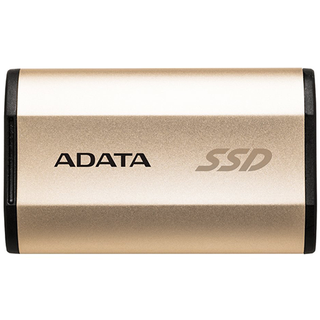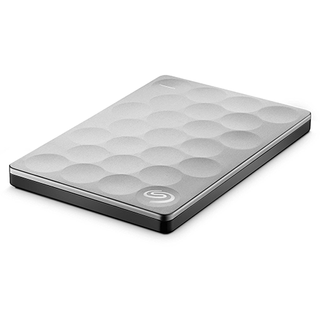Adata Portable SSD Roundup
Benchmarks And Conclusion
Comparison Products
We included three other portable products with a diverse background in our test pool, along with the Adata SV730 with MLC NAND and the Adata SC660 and SC620 with TLC NAND.
The SanDisk Extreme 500 Portable 240GB is another flash-based portable storage solution that fits easily into your pocket and takes on a less-than-traditional shape. SanDisk also lists the Extreme as dust and splash resistant. We tested this product back in May 2016.
We tested the Seagate Backup Plus Ultra Slim 2TB last September. Its selling price is slightly less than the three Adata flash-based products we have under the microscope, and it offers a massive capacity increase. The internal hard disk drive makes it more susceptible to falls, and it lacks the ability to chew through random and small-block data with the same performance as an SSD.
The LaCie Rugged RAID 4TB is what happens when a hard disk drive company wants to compete with NAND in performance and ruggedness. The drive features both Thunderbolt 2 and USB 3.0 5Gb/s connections and two internal 2TB hard disk drives running in either RAID 1 or RAID 0. The external case design and internal shock system increase the Rugged RAID's sustainability in a fall. The extra components add to the cost of the product. Expect to spend around $400 thanks to the expensive Thunderbolt bridge chip.
Sequential Scaling Block Sizes


We already noted the SC660 and SV620 utilize TLC NAND, but the SE730 uses the JMicron JMF670H controller. Even though the SE730 utilizes MLC NAND, it comes with the older and inconsistent controller that never evolved into a great (or even good) flash processor. Adata must have had an abundance of JMF670H controllers to choose it over a more modern component that would have increased the performance consistency and made for a better overall product for end users.
Our simple script measures performance as we increase the block sizes and all three Adata portable SSDs go haywire during the sequential write tests. More troubling, the SE730 with MLC NAND appears to have a panic attack during the read tests. We simply read back data from the drive at various block sizes during the relatively easy test, so the result is surprising. Neither of these tests should require any idle time between operations because the workload is light.
Full User LBA Span Performance


In this test, we read and write to the entire usable capacity with 128KB blocks. For hard disk drives, this test shows the declining performance as we move from the faster access area on the outer rim of the spinning disk to the slower inner portion. The decline happens while reading from and writing to hard disk-based storage.
The read test should produce a flat line with flash-based products because all of the data is in sequential 128KB blocks. Larger peaks and valleys during the test are a good indicator of a weak controller, insufficient DRAM and/or poor flash quality. Adata bins and packages flash that it buys at the wafer level. The high-quality flash goes into the enterprise and high-performance consumer SSDs, and the lower quality flash goes into other products (or the company sells it on the spot market). Adata labels the NAND packages, so we can't reference a guide to examine its quality.
The sequential write test shows how the TLC-based Adata portable SSDs lose performance and just how low it dips. Interestingly, the Seagate Backup Plus Ultra Slim 2TB with a single 2.5" 2TB hard disk drive inside outperforms the Adata SC660 and SV620 during more than 80% of the test. The two Adata SSDs will outperform the Seagate drive with small block access, but it is possible to transfer data faster with the Seagate SSD during large, sequential transfers.
File Transfers



I love testing storage products and plotting the results over time. We often see performance measured in throughput, but most people would rarely say, "Wow, that transfer was really fast—I bet it was doing at least 150 MB/s." Time-based results are easier to interpret because time is universal.
We tested with the Avatar (2D + 3D Edition) Blu-ray. We used rFactor from the post-installation directory (C:/Program Files) for the Game directory. The Directory Test is a 15.2GB block of data I modeled several years ago for another project. It comes from a daily-use notebook and contains a mix of images, software installations, ISO files, multimedia and so on, that yields a nice real-world workload.
The HDD-is-faster-than-TLC scenario plays out in real time in the first test, where we simply transfer a Blu-Ray ISO file to the external storage device. This is a single, large file transfer of roughly 50GB. The two Adata portable SSDs with TLC NAND take significantly longer to write the file than every other product in our test.
In the second test, we transfer an entire game (rFactor) directory to the portable device, and the three Adata flash-based products outperform every other device under test. A game directory primarily consists of small files with a handful of larger images and highly compressed data. When moving several small files, the flash chews through the workload like a champion Pac-Man player blazing through the early game levels.
We modeled our directory backup test after the files in the My Documents folder after a year of notebook use. The data is comprised of small, medium, and large- block data, and is essentially the same as dragging a folder from your computer to the device under test. We have to take aim at the Adata SE730 with MLC flash, but it is poorly paired with the aging and under-performing JMicron JMF670H controller. The SanDisk Extreme 500 Portable SSD rips through the data transfer in just 71 seconds. The slightly more expensive Adata SE730 250GB takes 124 seconds to complete the test (53 seconds longer).
Conclusion
There isn't a lot of innovation here, no real standout feature, or even a compelling reason to look in Adata's direction. If the SE730 240GB undercut the SanDisk Extreme 500 or 510 on price, we might have praised it for delivering a financially responsible portable SSD. Maybe if the Adata product was thinner, sleeker, or had something that made it stand out. As it sits now, the Adata SE730 250GB just gets lost in the infinite pages on Newegg. The drive would be better if Adata swapped the JMF670H controller for something more modern, like the 2-year-old SMI SM2246EN.
The Adata SC660 and SV620 are very similar, including the exact same underwhelming performance and restrictive TLC NAND. The chains of low performance keep you tied to your computer chair waiting for a file to transfer.
For me, most of my file transfers, at least the ones where time is important, occur when the family has to be somewhere. Even if I know a day before that we are leaving at 1 PM, I don't transfer the data until the last possible minute. What do serial procrastinators yell back when the family is on the way to the car? "I'll be there in a second, the transfer is almost done!"
If only there were a better way--or an Adata MLC-based portable SSD with a more modern controller to decrease the amount of time it takes to move the data faster. The SanDisk Extreme 500 Portable SSD 240GB keeps me out of trouble, as much as a portable SSD can. We like it a more than the Adata SE730 250GB for scenarios like the one above. The two TLC-based drives still come in a very external HDD shape that lacks the high-performance nature of flash. Flash is not always the fastest option when it uses three bits per cell (TLC) instead of two (MLC). TLC SSDs are cheap; they can take a decent shock, and you may need that when your wife smacks you over the head for making her sit in the car for five minutes.
Adata SE730 (250GB)
Reasons to buy
Reasons to avoid

Adata SC660 (240GB)
Reasons to buy
Reasons to avoid

Adata SV620 (480GB)
Reasons to buy
Reasons to avoid

MORE: Best SSDs
MORE: Latest Storage News
MORE: Storage in the Forums
Stay On the Cutting Edge: Get the Tom's Hardware Newsletter
Get Tom's Hardware's best news and in-depth reviews, straight to your inbox.


